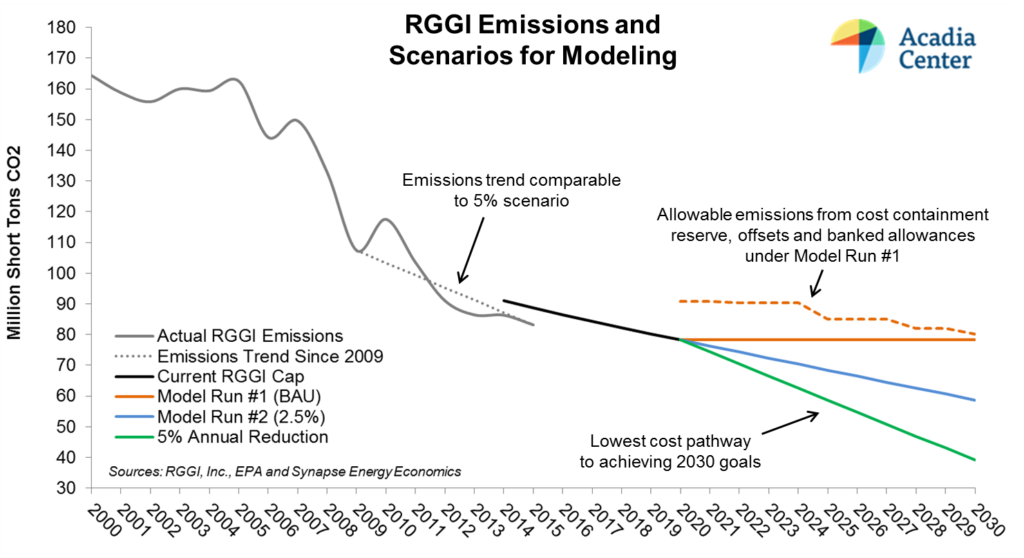CT Losing Ground on Greenhouse Gas Emissions
…The state is legally required to reduce greenhouse gas emissions to 10 percent below 1990 levels by the year 2020. But new analysis by the Acadia Center shows the state’s total greenhouse gas pollution has increased almost 4.5 percent since 2012. Jamie Howland, director of Acadia’s Climate and Energy Analysis Center, says that follows what had been an eight-year trend of overall reductions. “2012 was the lowest year for emissions and so, in 2013 and 2014, emissions are now above that – and I think clearly above the 2020 target as well,” he says…
RGGI modeling should be more expansive – environmental groups and power companies agree
Later this year, Northeast and Mid-Atlantic states will determine the future of the successful, first-in-the-nation climate program for the power sector, the Regional Greenhouse Gas Initiative (RGGI). The most important decision centers on the cap level, the primary indicator of the program’s environmental ambition. Before the RGGI states ultimately decide on a post-2020 cap level, however, they will model the impacts of a range of possible cap scenarios. It is with that range in mind that the Collaborative for RGGI Progress (“the Collaborative”) urged the RGGI states to broaden their proposed scope of modeling when they submitted comments last week.
The Collaborative is a unique coalition that includes two of the region’s largest power generators (Calpine and Exelon), one of the largest utilities (National Grid), and environmental organizations (Acadia Center and Natural Resources Defense Council). By finding common ground among diverse interests, the Collaborative seeks to propel balanced policy that advances RGGI states’ climate leadership.
At a February meeting in Delaware, the RGGI states proposed to model just two scenarios: one that reflects doing the bare minimum to comply with the requirements of the Clean Power Plan (see “Model Run #1” in the figure below), and a second that essentially continues the current RGGI cap trajectory of 2.5% per year through 2030 (see “Model Run #2” in the figure)¹. The Collaborative commends the RGGI states for modeling these two scenarios, but also requests the modeling of two more ambitious scenarios:
- A 5% annual reduction per year from the 2020 cap level from the electric sector from 2021 to 2030 (the green line in the figure); and
- A scenario that aligns electric industry emissions reductions with RGGI states’ shared commitment to 80% economy-wide GHG reduction targets by 2050.
The 5% annual reduction scenario would provide the states with more information on options for achieving deep, economy-wide emissions reduction commitments, and there is ample quantitative justification to model this specific scenario. As discussed in more detail in more detailed comments to RGGI, Inc. by NRDC, an annual 5% reduction from 2020-2030 would be on par with the actual emissions reductions that have occurred since RGGI began in 2009. RGGI has also generated billions of dollars in economic benefits since 2009, and modeling of a similar emissions reduction trajectory going forward will enable states to assess the impacts of continuing along a comparable glide path. RGGI modeling should also be used to evaluate the contribution that the program can make to achieve the RGGI states’ ambitious, long-term, economy-wide GHG reduction targets. A recent analysis from Synapse Energy Economics indicates that the most cost-effective pathway to achieving those targets translates to annual RGGI cap reductions of approximately 5% from 2020-2030. While the RGGI modeling will not encompass the building and transportation sectors – as Synapse’s analysis did – it affords an opportunity to evaluate how far the electric sector can go toward achieving multi-sector requirements.
This is not the first time that stakeholders have asked the RGGI states to model this 5% cap scenario; in previously submitted comments, environmental advocates, public health groups, clean energy companies and a representative of Fortune 500 businesses have all made compelling cases for the inclusion of this modeling run. However, these comments from the Collaborative represent the first time that RGGI compliance entities and electric utilities have weighed in to support this modeling.
The request is simple, the justification is clear, and the support is abundant. If the RGGI states intend to achieve their long term goals, they need to begin considering the pathways that will actually get them there. Modeling the impacts of a cap that declines by 5% of the 2020 level each year through 2030 is a key step in that process.
¹ From 2014 -2020, the cap declines annually by 2.5% of the preceding year’s cap level, while the proposed trajectory from 2020-2030 would be an annual decline of 2.5% from the 2020 level. The proposed 2.5% cap through 2030 would also eliminate the cost containment reserve and prohibit the use of offsets.
 Jordan Stutt is a Policy Analyst in Acadia Center’s Boston office. He works on energy, transportation and climate change issues, with an emphasis on research and policy analysis for energy systems and carbon markets. He was an Energy Policy Analyst at Pace Energy and Climate Center, Pace University Law School in White Plains, NY, where he focused on energy efficiency and RGGI.
Jordan Stutt is a Policy Analyst in Acadia Center’s Boston office. He works on energy, transportation and climate change issues, with an emphasis on research and policy analysis for energy systems and carbon markets. He was an Energy Policy Analyst at Pace Energy and Climate Center, Pace University Law School in White Plains, NY, where he focused on energy efficiency and RGGI.
 Peter Shattuck is Director of Acadia Center’s Massachusetts office and Clean Energy Initiative. Peter’s work at Acadia Center focuses on cleaning up the energy supply across all sectors of the economy. Driving market-based emissions reductions is at the core of this work, using cap and trade policies such as the Regional Greenhouse Gas Initiative, which Acadia Center has tracked since the program’s early development in the 2000s.
Peter Shattuck is Director of Acadia Center’s Massachusetts office and Clean Energy Initiative. Peter’s work at Acadia Center focuses on cleaning up the energy supply across all sectors of the economy. Driving market-based emissions reductions is at the core of this work, using cap and trade policies such as the Regional Greenhouse Gas Initiative, which Acadia Center has tracked since the program’s early development in the 2000s.
Rooftop solar: Net metering is a net benefit
…Likewise, a study by Acadia Center found the value of solar to exceed 22 cents per kWh of value for Massachusetts ratepayers through reduced energy and infrastructure costs, lower fuel prices, and lowering the cost of compliance with the Commonwealth’s greenhouse gas requirements. This value was estimated to exceed the retail rate provided through net metering…
Analysis Finds Greenhouse Gas Emissions Rising In State
The study by the nonprofit Acadia Center indicates that carbon dioxide emissions from Connecticut sources rose by about 4.4 percent over 2013 and 2014. The previous eight years had seen repeated declines in the state’s CO2 emissions.
Officials at the Acadia Center, which has been tracking this region’s energy conservation efforts and air pollution for more than 15 years, said the CO2 pollution increase appears to be linked to transportation sources. They warned this trend could put Connecticut’s air pollution goals in jeopardy if it continues, and called for more aggressive state efforts toward alternative energy sources and conservation.
“This new, sustained upward trend in Connecticut’s greenhouse gas emissions is a cause for concern,” said Daniel L. Sosland, Acadia Center president. “We cannot afford to backslide any further.”……. (see article for more)
New Analysis Shows Connecticut’s Greenhouse Gas Emissions Have Increased Since 2012; No Longer on Track to Meet State’s 2020 Target
Hartford, CT – Acadia Center today released new analysis showing that Connecticut’s total greenhouse gas (GHG) emissions have reversed course and increased by 4.4% since 2012. Using the most recent data available on actual GHG emissions, Acadia Center found that total GHG emissions increased from 39.6 million metric tons carbon dioxide equivalent (MMTCO2e) in 2012 to 41.3 MMTCO2e in 2014 – a net increase of 1.7 MMTCO2e. This is the first two-year increase in GHG emissions for Connecticut since 2003-2004.
Acadia Center’s analysis also found that the GHG emissions level in 2014 was more than the state’s mandatory 2020 GHG emissions cap, exceeding it by nearly 1.5 MMTCO2e, or 3.7%. Connecticut’s Global Warming Solutions Act, passed in 2008, set a binding target of reducing GHG emissions to at least 10 percent below 1990 levels by 2020. The new emissions data indicates that Connecticut is not on track to satisfy this legal requirement. In fact, preliminary data for 2015 suggests that emissions for this past year will be even higher than the level for 2014.
“This new, sustained upward trend in Connecticut’s greenhouse gas emissions is a cause for concern,” said Daniel L. Sosland, Acadia Center President. “We need stronger and faster reductions in GHG emissions through policies that we know are effective, such as eliminating costly energy waste, reforming our energy rules so that investments in exciting, community oriented clean energy technologies can flourish, and increasing our clean energy supply. It is crucial that the state’s upcoming Comprehensive Energy Strategy establish a clear policy path that will bring the state into compliance with its 2020 GHG emissions limit. We cannot afford to backslide any further.”
The rise in Connecticut’s GHG emissions from 2012 to 2014 comes after eight years of generally declining emissions from an historic peak in 2004. Acadia Center examined Connecticut’s GHG emissions at the sector level and found that the largest contributor to the state’s emissions was the transportation sector.
“We need to move quickly and aggressively if we are to have any real chance of complying with the state’s 2020 GHG emissions limit,” said Jamie Howland, Director of Acadia Center’s Climate and Energy Analysis Center. “Based on this latest data, Connecticut will need to wipe out the recent increase in a little over three years to meet the 2020 mandate. We face a major challenge, but it’s achievable if we immediately expand policies we already have in place, such as ramping up our energy efficiency investments and renewables goals to those of leading states, strengthening the Regional Greenhouse Gas Initiative’s emissions cap, and avoid locking into long-term emissions increases with new fossil fuel infrastructure projects.”
Acadia Center’s latest analysis of Connecticut’s GHG emissions updates its previous inventory of the state’s emissions released in 2013 through its ClimateVision 2020 report. The original ClimateVision 2020 report is available online: http://climatevision.acadiacenter.org/sites/default/files/ENE_ClimateVision2020_v1.1_0.pdf.
Acadia Center analyzed new GHG emissions data for 2013 and 2014 recently released by the U.S. Energy Information Administration using the U.S. Environmental Protection Agency’s State Inventory Tool.
Contact:
Jamie Howland, Director, Climate and Energy Analysis Center
860-246-7121 x201, jhowland@acadiacenter.org
Bill Dornbos, Senior Attorney & Director, Connecticut Office
860-246-7121 x202, wdornbos@acadiacenter.org
###
Acadia Center is a non-profit, data-driven research and advocacy organization committed to advancing the clean energy future. Acadia Center is at the forefront of efforts to build clean, low-carbon and consumer-friendly economies. Acadia Center provides accurate and reliable information, and offers a real-world and comprehensive approach to problem solving through innovation and collaboration. Acadia Center’s Connecticut Office focuses on developing and implementing solutions to Connecticut’s climate and energy challenges.
Forests and Climate Change – From Offsets to What?
In 1994 Greenpeace released a report called “The Carbon Bomb: Climate Change and the Fate of the Northern Boreal Forests”. The report warned that between 50 and 90 percent of the existing boreal forests were likely to disappear as a result of climate changes that would happen if atmospheric levels of carbon dioxide doubled. Warmer and drier conditions stress trees directly, as well as contributing to conditions that could lead to more frequent fires and pest outbreaks. If boreal forests continued to decline, they could release of up to 225 billion metric tons of extra carbon into the atmosphere, increasing current levels by a third.
The recent wildfires that have burned roughly 874,750 acres in Fort McMurray, Canada are a sign that the carbon bomb may be beginning to explode. An El Nino year contributed to a particularly dry winter, and record temperatures and low humidity this May set the stage for a brutal fire season. While individual occurrences of fires, just as individual occurrences of hurricanes, are impossible to tie to climate change, scientists agree that more frequent and intense fires on average are expected.
According to Natural Resources Canada, the boreal forest, or taiga, covers 3.7 billion acres, or which makes up a third of the world’s forests. It extends through Alaska and Canada in the Western hemisphere, and Scandinavia, Russia and northern Asia. In addition, boreal soils include large areas of permafrost and peatlands, which themselves can be large sources of carbon and methane, an even more potent greenhouse gas, if they breakdown through thawing or burning. Currently, more than 4.9 million acres of forest burn each year in Canada. This is twice the average area burned in the early 1970s.
 Forests play an incredibly important role in climate change internationally and nationally, but policy solutions have proven elusive in the United States. In May of 2008, Acadia Center (then Environment Northeast), Manomet and the Maine Forest Center, released recommendations for how to expand forest offset categories in the Regional Greenhouse Gas Initiative (RGGI). These recommendations outlined how, with rigorous measurement and verification, projects that decreased carbon emissions from logging and land development could be used to meet part of the emissions requirements of the program.
Forests play an incredibly important role in climate change internationally and nationally, but policy solutions have proven elusive in the United States. In May of 2008, Acadia Center (then Environment Northeast), Manomet and the Maine Forest Center, released recommendations for how to expand forest offset categories in the Regional Greenhouse Gas Initiative (RGGI). These recommendations outlined how, with rigorous measurement and verification, projects that decreased carbon emissions from logging and land development could be used to meet part of the emissions requirements of the program.
In 2013, the RGGI states released updated program rules which incorporated these new forest categories, harmonizing rules with a similar program in California. To date the low price of auction allowances has meant that no forest projects have been used to comply with RGGI. However, some forest offset projects located in the Northeast have been registered in the California carbon market, which has had much higher prices.
At the federal level, implementation of EPA’s Clean Power Plan, which aims to reduce carbon dioxide emissions from power plants in the US, has been stayed by the Supreme Court. If the program goes forward, it is expected that states that are already implementing emission reduction programs, such as RGGI, will be allowed to use these programs to comply with the federal program. The role of offsets in meeting EPA requirements remains uncertain.
Clearly, protecting the carbon stored in forests is essential to preventing a dangerous climate tipping point. However, the threats to forests from climate change itself, as shown in the fires raging around Fort McMurray, highlight that concerns over the permanence of carbon stored in forest projects were not misplaced.
Additional Reading
The Carbon Bomb: Climate Change and the Fate of the Northern Boreal Forests – by Greenpeace, 1994
Forest Future: The Role Forests Can Play in Addressing Climate and Promoting Sustainable Economies – by ENE (now Acadia Center), 2010
Turning Up the Heat: Global Warming and the Degradation of Canada’s Boreal Forest – by Greenpeace, 2008
 Ellen Hawes is the Senior Analyst, Energy Systems and Carbon Markets at Acadia Center. Ellen’s work as senior analyst focuses on energy systems, land use and carbon markets. She also leads Acadia Center’s participation in New Hampshire energy policy work. Ellen received her Master in Forestry from the Yale School of Forestry and Environmental Studies.
Ellen Hawes is the Senior Analyst, Energy Systems and Carbon Markets at Acadia Center. Ellen’s work as senior analyst focuses on energy systems, land use and carbon markets. She also leads Acadia Center’s participation in New Hampshire energy policy work. Ellen received her Master in Forestry from the Yale School of Forestry and Environmental Studies.
Attleboro area residents, officials vow to continue to fight plans for gas pipeline
…Peter Shattuck, director of the Clean Energy Initiative for the Acadia Center, a Boston-based environmental group, said burning additional gas could prevent the state from meeting future clean air goals….
Policy & Pinot: Greening Rhode Island’s Energy Grid
This month’s Policy & Pinot will focus on the state of the region’s energy grid, which has undergone dramatic changes. Older oil- and coal-fired power plants are retiring, while natural gas production is increasing. State laws requiring ambitious reductions in greenhouse gas emissions have been driving the shift toward cleaner energy from the sun, wind and water.
Located at Save the Bay’s offices overlooking Narragansett Bay, and moderated by RIPR environmental reporter Ambar Espinoza, we’ll talk with our guest panelists about what the future grid could look like, how greener energy may impact consumers, and how Rhode Island’s progress compares to other states.
Ambar Espinoza : Environmental Reporter, RIPR (moderator)
Danny Musher : RI Office of Energy Resources
Abigail Anthony : Director of Grid Modernization & of the RI office, Acadia Center.
Mary Louise Nuara : External Affairs Representative for CT & RI, ISO New England
Listen to the full show at http://ripr.org/post/policy-pinot-greening-rhode-islands-energy-grid.
Virtual Net Metering bill headed to governor’s desk
…With a special session expected next week, much is still unclear about the budget and its impact on clean-energy funding.
The Acadia Center’s Connecticut Director William Dornbos said Thursday that his nonprofit remained concerned about whether a proposed raid of clean energy funds would end up in the final budget. That raid, originally proposed at $42 million, was reduced to just over $3 million recently.
“…the raid, at any amount, still sets a bad policy precedent for future legislative sessions,” Dornbos said. “We are worried that these funds, which come from the state’s participation in the Regional Greenhouse Gas Initiative, will be increasingly looked to as a budget band-aid in future sessions, especially since the state’s long-term budget picture still looks difficult.”
Should we promote heat pumps to save energy and reduce greenhouse gas emissions?
…Additional energy would be saved from using heat pumps instead of gas furnaces in some important applications. Furthermore, multiple analysts (e.g., here and here) see electric heat pumps powered with clean electricity as an important strategy for displacing emissions from in-home combustion of fossil fuels…



















